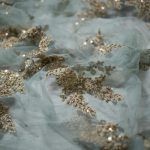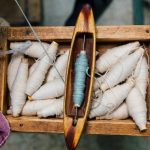When you encounter gossamer fabric, you're looking at a textile celebrated for its lightweight and ethereal qualities, often made from silk, nylon, or polyester. Its creation involves a meticulous process of spinning and weaving delicate fibers, but there's much more to explore regarding its historical significance and the intricacies of its manufacturing. You might be surprised at how those seemingly simple strands come together to create a fabric that's both stunning and practical. What could be the implications of its delicate nature in various applications?
Table of Contents
Definition of Gossamer Fabric
Gossamer fabric is a lightweight, sheer textile that's often characterized by its delicate, translucent appearance. You'll find this fabric used in various applications, from clothing to crafts, due to its ethereal quality.
When you touch gossamer, you might notice how soft and airy it feels, which makes it perfect for creating layers without adding much weight. Typically, gossamer is made from materials like silk, nylon, or polyester, and it can even come in blends.
You might encounter it in soft, flowing dresses, scarves, or as a delicate overlay in formal attire. Its lightweight nature allows for ease of movement and a graceful drape, turning any garment into a whimsical piece.
While gossamer is stunning, it requires careful handling since it can snag or tear easily. Matching this fragile textile with appropriate underlayers is essential for achieving a stylish look while ensuring longevity.
Historical Background
Dating back to ancient times, lightweight and sheer fabrics have been cherished for their beauty and versatility in various cultures. You can trace the roots of gossamer fabric to regions like China and the Middle East, where silk was prized for its delicate nature. Ancient artisans mastered the craft of weaving, creating airy textiles that draped gracefully and added elegance to garments.
As you explore history, you'll find that during the Renaissance, gossamer-like fabrics flourished in Europe. Royalty and the wealthy donned intricately designed garments made from these materials, showcasing their status and taste.
In the 18th century, the advent of organza and tulle further popularized gossamer in fashion, adding delightful elements to dresses and veils.
Fast forward to today, gossamer's legacy endures in modern fashion and design. It remains a symbol of ethereal beauty, capturing attention in a variety of contexts, from haute couture to home decor.
Fabric Composition
Understanding gossamer fabric's historical significance sets the stage for exploring its unique composition, which typically blends lightweight fibers like silk, nylon, or polyester to achieve its signature translucence and airy feel. These materials are chosen not only for their lightweight characteristics but also for their ability to drape beautifully.
Silk, known for its luxurious touch, offers a natural sheen and breathability, making it perfect for creating delicate apparel. You can appreciate how the soft texture of silk enhances the overall elegance of gossamer fabric.
On the other hand, synthetic fibers like nylon and polyester provide durability and resistance to wrinkling, ensuring that the fabric maintains its form while remaining easy to care for.
When you see gossamer fabric in action, you'll notice its exquisite ability to float and flutter, adding an ethereal quality to garments or décor. The fusion of these components allows designers to create striking pieces that are both visually appealing and functional.
Whether you're considering wearing gossamer fabric or using it in a project, understanding its composition helps you appreciate its qualities and versatility.
Manufacturing Process
The manufacturing process of gossamer fabric involves weaving lightweight fibers together in a manner that enhances their delicate nature while maintaining structural integrity.
You'll start by selecting the right materials, typically silk or fine synthetic fibers that contribute to the fabric's ethereal quality.
After choosing your fibers, the following steps are essential:
- Preparation: Clean and condition the fibers to ensure smooth weaving.
- Spinning: Twist the fibers into yarn, creating a lightweight but durable thread.
- Weaving: Use a loom to interlace the yarns, ensuring a loose and airy structure that allows light to filter through.
- Finishing: Apply treatments to soften the fabric and enhance its draping qualities, making it even more delicate.
Throughout this process, attention to detail is crucial. By focusing on each step carefully, you'll create gossamer fabric that captures the light and embodies elegance, making it ideal for various future applications.
Applications and Uses
How can gossamer fabric enhance a variety of applications, from fashion to home decor?
This lightweight, sheer material brings a delicate touch to your wardrobe, making it perfect for creating ethereal dresses, flowing skirts, or elegant shawls.
As you style your outfits, gossamer can add depth and dimension, allowing layering opportunities that make your look stand out.
In home decor, gossamer fabric shines through curtains, table runners, or accent pillows. Its translucent nature softens sunlight, creating a warm and inviting atmosphere.
You can even use it for special occasions like weddings or parties, draping it over tables or around ceilings for an enchanting effect.
Moreover, gossamer's versatility extends to crafts and DIY projects.
Whether you're making personalized gifts or unique decorations, this fabric can inspire creativity.
Outdoor enthusiasts appreciate gossamer for items like lightweight tents or bags, as it balances strength and weight.
Frequently Asked Questions
Is Gossamer Fabric Machine Washable?
You can't machine wash gossamer fabric. Its delicate nature requires careful handling, so hand wash it gently in cool water with mild detergent. Always air dry to maintain its quality and prevent damage in the future.
Can Gossamer Fabric Be Dyed Different Colors?
Yes, you can dye gossamer fabric different colors, but be careful. Use suitable dyes for delicate materials, and always test on a small sample first to ensure the color adheres properly without damaging the fabric.
What Are the Differences Between Gossamer and Other Lightweight Fabrics?
Gossamer's sheer quality and delicate texture set it apart from other lightweight fabrics. While similar to chiffon and organza, it's often lighter and more ethereal, giving your projects a unique, airy appeal that others lack.
How Durable Is Gossamer Fabric for Everyday Use?
Gossamer fabric isn't the most durable choice for everyday use. While it's lightweight and delicate, it can easily snag or tear. You'll want to reserve it for special occasions rather than daily wear.
Are There Any Eco-Friendly Options for Gossamer Fabric?
Yes, there are eco-friendly options for gossamer fabric. You can explore alternatives made from organic cotton, bamboo, or recycled materials that reduce environmental impact while providing the delicate qualities you love in traditional gossamer.
- Exploring the Quality of Cotton Fabric From Chinese Manufacturers - June 20, 2025
- A Buyer’s Guide to China’s Lace and Chiffon Fabric Markets - June 20, 2025
- The Enduring Popularity of Blue and White China Print Fabric - June 20, 2025







